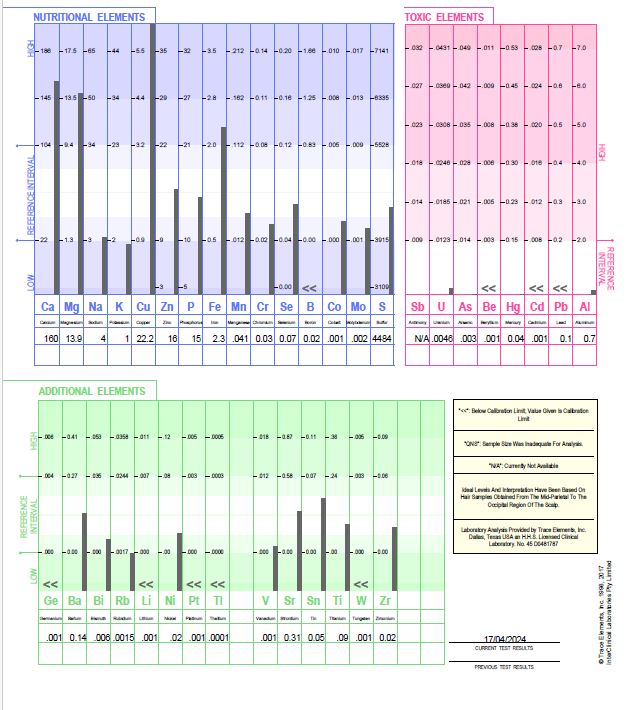Hair Tissue Mineral Analysis
Identify mineral deficiencies, excesses, and imbalances.
Hair Tissue Mineral Analysis (HTMA) is a quantitative test that measures the mineral composition of hair, (precise to parts per million). It is a safe and non-invasive test that reflects the level of nutrients and toxic elements in body tissue.
Hair is utilised for mineral testing due to its inherent characteristics. It is composed of specialized cells forming clusters within the hair follicle. As the hair grows, it is exposed to internal bodily fluids such as blood, lymph, and extra-cellular fluids (swap right for the picture). Upon reaching the skin’s surface, the outer layers of the hair harden, preserving metabolic products accumulated during its growth. This biological process serves as a lasting record of mineral status, nutritional intake, and metabolic activity during this period.
The analytical method for determining mineral levels in hair is highly sophisticated. When conducted meticulously and interpreted accurately, it can serve as a screening tool for identifying mineral deficiencies, excesses, and imbalances. HTMA offers an economical and sensitive means for assessing the long-term effects of factors like diet, stress, and exposure to toxic metals on mineral balance, which may not be easily obtained through other clinical tests.
What can Hair Tissue Mineral Analysis Reveal:
• Adrenal & thyroid function
• Mineral deficiencies and excesses
• Metabolic rate (fast or slow)
• Heavy metal toxicity
• Liver & kidney state
• Immune state
• Mental health state
• Nervous system imbalance
• Cardiovascular health state
• Diabetes and insulin resistance
• Sports endurance & recovery
• Energy levels & fatigue
Advantages of HTMA:
• Safe, scientific, and non-invasive.
• Provides reliable data on up to 35 nutrients and toxic minerals, along with over 25 important mineral ratios.
• Detects imbalances in nutrient minerals or excesses in toxic minerals affecting health.
• Offers valuable health insights not typically revealed in standard blood and urine tests.
• Hair is less affected by rapid changes in trace element levels compared to blood.
• Hair serves as a record of both past and present trace element levels, indicating long-term deviations in mineral retention or losses.
• Personalised interpretive reports assess current mineral status, highlight concerns, and suggest dietary changes and supplements for better health and well-being.
Who can do HTMA:
• Children
• Elderly
• Preconception
• Menopause
• Athletes
• Anyone

